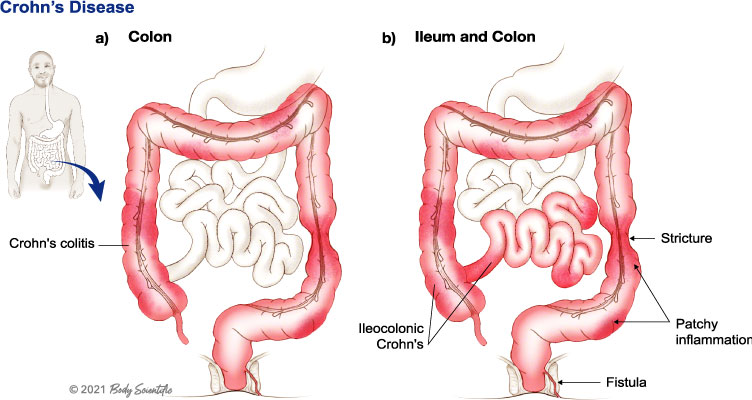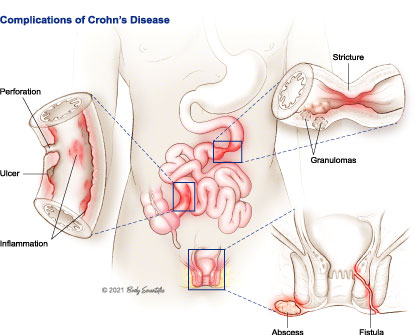Crohn’s disease is a type of inflammatory bowel disease (IBD), which is a chronic inflammatory condition of the gastrointestinal tract with increasing global incidence and prevalence.
In the United States alone, as of 2015, the estimated numbers of IBD patients are approximately 1.3% of the population and counting, or upwards of 3.1 million people. 1
Around the world, those numbers are upwards of 6-8 million and some sources cite as many as 10 million IBD patients globally. 2
Crohn’s Disease presents as the following:
Crohn’s disease presents as chronic inflammation that generally affects the ileum (end of small intestine) and the first portion of the colon.
In the small and large intestines, Crohn’s disease commonly presents as ileocolonic Crohn’s (inflammation in the terminal ileum (end of small intestine)) and first part of the colon or as Crohn’s colitis (Crohn’s inflammation in the colon and rectum).
Inflammation within the intestines may create “skip lesions,” where there is patchy inflammation in some areas and no inflammation in other areas.
The disease can occur at any age, but Crohn’s disease is most often diagnosed in adolescents and adults between the ages of 15 and 35.
Crohn’s disease can affect and penetrate the thickness of the bowel wall (throughout the small and large intestines).
To better understand what sections of the gut Crohn’s disease effects, please see the red areas of Figure 1.
Complications of Crohn’s disease
Abscess: An abscess is a collection of pus caused by a bacterial infection.
Bowel Perforation: Severe inflammation may result in a hole developing anywhere along the gastrointestinal tract which can lead to sepsis; sepsis is very serious and usually requires immediate surgical attention.
Fistulizing disease: According to studies, 35-50% of Crohn’s disease patients develop at least one fistula. 3 Fistulae are complications of Crohn’s disease that follow damage to the lining of the intestines and result in abscesses and abnormal tunnels between the intestine and other organs (e.g., bladder), or out onto the exterior surface of the skin. Many fistulae can develop within the anal and genitourinary areas (scrotum, penis, vulva, vagina, etc.), and are often referred to as perianal disease.
Stricturing disease: Another complication of Crohn’s disease is an intestinal stricture, which is a narrowing of the intestine from severe inflammation. Strictures obstruct contents from passing through the intestine or bowel and can result in intestinal blockages and sometimes bowel perforations.
To better understand what these complications of Crohn’s disease look like anatomically, please refer to Figure 2.
Written by Tina Aswani Omprakash. Medically reviewed and validated by Jordan Axelrad, MD, MPH. These webpages are funded by a grant from The Leona M. and Harry B. Helmsley Charitable Trust.






